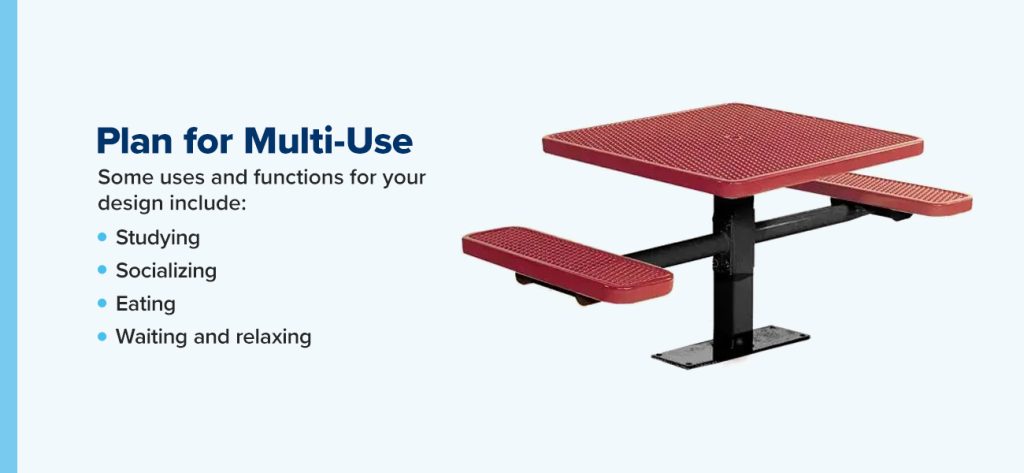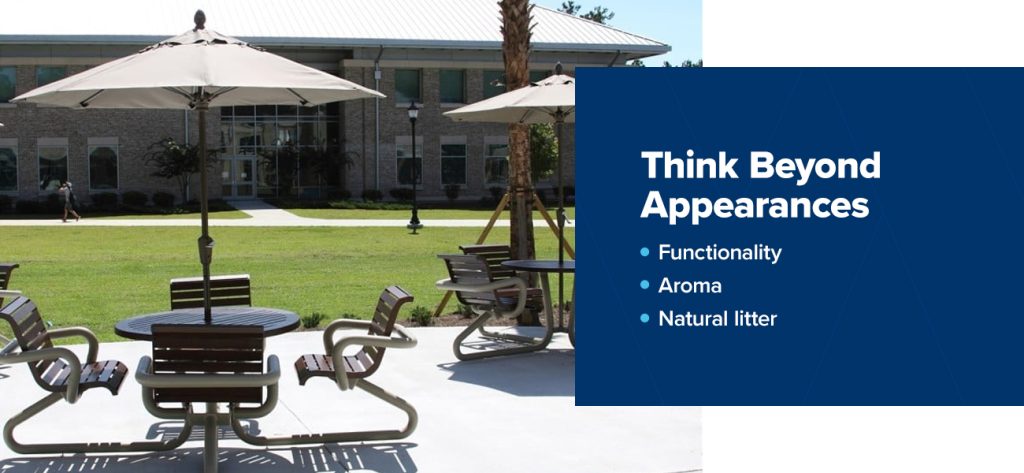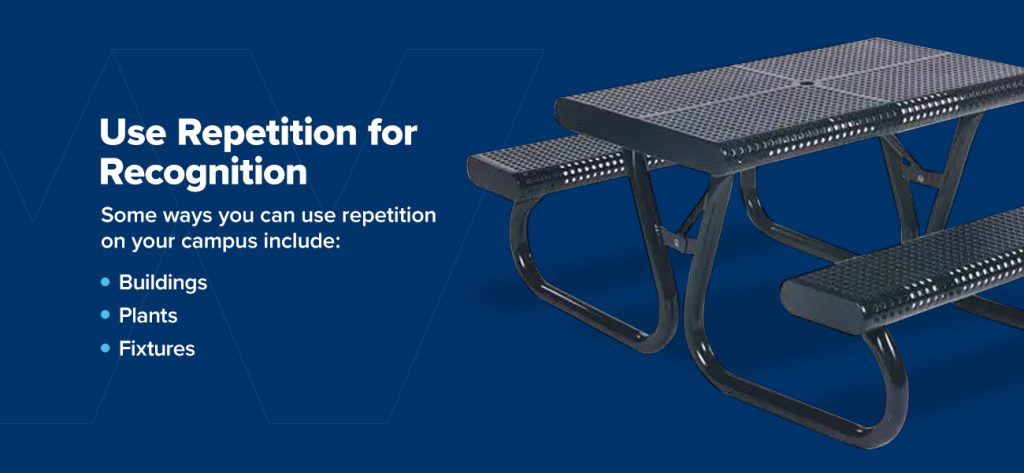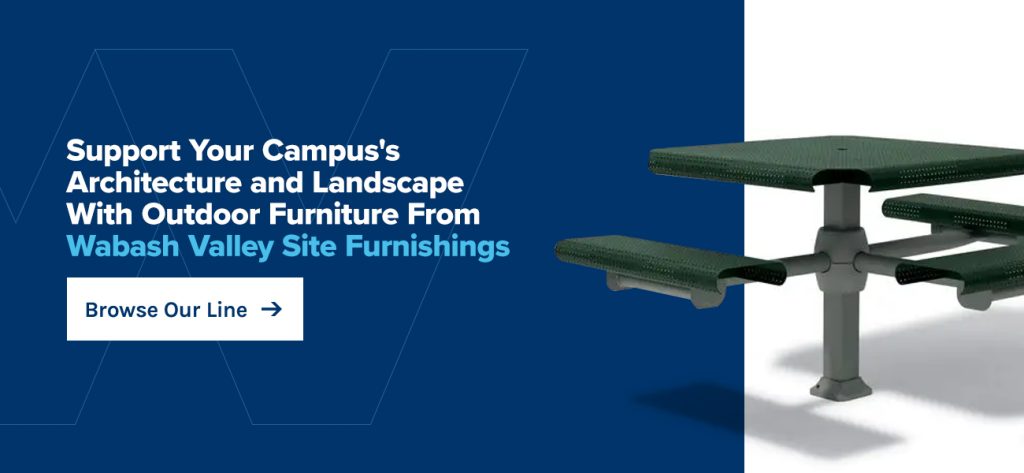Guide to College Campus Landscape Architecture

Uncategorized | Jan 4, 2023
Landscaping your university campus? Using a guide can ensure your school includes every consideration and benefit in the planning and design stage for better results that meet your school’s goals.
1. Consider Campus Needs
Your campus has to serve several unique populations, each with various needs and desires. Each student will look for something different from their university. Further, your faculty, families and recruiters also have goals they can accomplish with your campus. Incorporating these needs into your landscape design and architecture can make it more actionable and successful.
Some goals you might aim to accomplish with your campus’ landscape architecture include:
- Flow
- Accessibility
- Flexibility
- Weather protection
- Comfort
Optimizing your design to support your community’s various needs and wants can provide a campus that continues to attract and retain students.

2. Plan for Multi-Use
Campuses support several populations, from current students living and studying on campus to faculty and commuting students arriving each day. Families and potential students visit campuses and take tours to determine if your school is right for them. Your campus landscape and architecture should be flexible, allowing visitors and students to choose how they want to use available space and furniture.
Some uses and functions for your design include:
- Studying: When the weather is nice, many students take advantage of it by studying outside. Whether sitting at tables or laying out blankets on a lawn, your college architecture and landscaping can support several study habits. Place some areas away from high-traffic spaces and intersections to support quiet study. Alternatively, placing tables or benches close together can promote collaboration when students have group research or projects to work on.
- Socializing: While students might pick schools for their academic programs, many seek a particular social experience. College is a chance to make new friends, and your landscape and architecture can support increased socialization. Open spaces with many places to gather can allow students to group and talk without disturbing those studying indoors or outside. Students can meet together or use the familiar, safe environment to take chances and introduce themselves to new people.
- Eating: Your dining halls surely support students’ appetites and nutritional needs. However, students might want more freedom to choose their dining experience. Outdoor tables, benches and lawns can encourage students to eat outside.
- Waiting and relaxing: Students have busy schedules but might also have awkward gaps between classes, clubs or work. Commuters need diverse locations to spend on campus without driving back home after each class. Your landscaping can provide a peaceful, relaxing place where students can sit until their next activity.
When your campus landscape and architecture can meet several functions and purposes, your students can better enjoy these spaces by adjusting them to their needs.
3. Focus on Sustainability
Your campus can better support its greater community through its landscape design’s sustainability. Incorporating green habits into your landscape maintenance and upkeep will support a more positive experience with your campus for students, staff and surrounding populations.
When you want to provide flexible spaces, you can support various needs with waste management solutions. Strategically placed trash receptacles and recycling cans will prevent littering while encouraging students to study, socialize and eat outdoors. Entrances and exits are great locations for trash solutions, but putting them along walkways, courtyards and lawns can further support clean outdoor areas when campuses are so large.
Your plant care regiments should support local ecosystems and sustainability. Pesticides and other chemical treatments can seep into local water systems, harming plants, animals and aquatic life.
4. Use Local Plants
Another way to avoid pesticides and uphold sustainability is by planting local fauna. Because they are part of the local ecosystem, these trees, shrubs and flowers will thrive under weather conditions, preventing excess water use or chemical protective measures. They will also attract local pollinators, which are essential for maintaining ecosystems and other animal populations.
Local plants can also provide a unique experience for out-of-state students. When they travel to your campus, they will feel like they are somewhere new, adding to their college experience. Environmental students can study these plants and flowers in classes for hands-on applications and relevant lessons. Plants and trees can tell the area’s history, tying nature to important local events your students can study and learn about in classes.
When selecting your plants, you can simplify processes by choosing plants that will regrow each spring without replanting. Your college can save money on landscape efforts while providing students with a seasonal visual experience.

5. Think Beyond Appearances
Plants and landscaping can add essential visual elements to your campus and architecture. However, greenery has more impact beyond aesthetics. Your plant choices can offer various experiences to campus visitors, impacting them in multiple ways and changing their perception of your school. When you want to provide a particular image or experience, your plant choices can provide the following:
- Functionality: Your plants, shrubs and trees can provide physical functions. Flower beds and bushes can serve as borders between different areas, separating places with other purposes or adding some privacy. Trees offer shade, creating more comfort when it’s hot out. Sprawling lawns can function as sitting spaces, encouraging students to picnic with friends.
- Aroma: Plants have various odors, especially when blooming. You can use your plants to provide a specific olfactory experience on campus. Choose plants with their scent in mind so you find something pleasant and support students spending long periods around them. Strategic placement can help cover up the smell of dining hall food or trash cans for additional positive experiences.
- Natural litter: Plants produce byproducts as they grow and change with the seasons. Trees and shrubs might shed leaves in the fall and flowering plants will make pollen and seeds in the spring. This natural litter can impact your maintenance and landscaping processes. You might have to schedule people to rake leaves in the fall, so students can continue to enjoy sidewalks and grass without slipping. Pollen can cause allergies in some students, and seeds might lead to excess plants you don’t need.
Thinking beyond what plants can offer visually will help your landscaping teams create a more enjoyable overall experience for students and faculty.
6. Integrate Urban Spaces
Urban campuses are unique spaces that attract students looking for city life and education. However, urban colleges can still provide landscaped green areas for students. With city schools, flow and creativity are essential. You want to connect students naturally to your gardens or parks while using the available space.
Sidewalks, steps, streetlights and other amenities are great ways to create flow, drawing students and faculty into your green spaces. You can add to flow by placing green spaces between academic buildings or campuses, providing students a straightforward way to get to other classes or dorms.
Cities have different challenges when landscaping because of these locations’ increased capacity and density. Some ways your school can add some greenery and landscaping amongst shared urban spaces include:
- Rooftop gardens
- Courtyards within buildings
- Fountains surrounded by gardens
- Trees, shrubs and flowers bordering buildings
Working with urban landscapers can help your university discover the right architectural landscaping design.
7. Look for Balance
Balance in architectural design often refers to symmetry. Symmetrical designs can bring order and uniformity to campuses, creating a calm, safe environment students can rely on. Many designers use walkway placement, plant shapes and even building design to create symmetry on campus. However, too much symmetry can become lifeless and still. Maintaining perfection might require more maintenance.
Asymmetry can bring more life, relaxation and flow to architectural spaces. You can use various features to break up areas and add something exciting that keeps students and visitors engaged, like fountains, clocktowers and gardens. Like symmetry, asymmetry is best in moderation — overdoing asymmetrical features can feel chaotic and confusing. People need a balance of excitement and order.
Balance goes beyond placement and symmetry. You should consider how frequently you use design elements like shapes, textures and colors. While staple features are important, too many can cause them to blend into architecture instead of standing out. Alternatively, choosing too many design elements can overload senses and make it hard for campus visitors to focus. Finding the balance between features and design is critical for creating a beautiful campus that supports student and faculty needs.
8. Streamline Transportation
College campuses are full of movement. Students are bustling to and from classes, commuters are coming and going, clubs are hosting events and dining halls are full of hungry students. Faculty and professors are moving from various meetings and lectures throughout the day. Your landscape can be a handy tool when you want to control movement and flow.
When designing your campus’s landscape, make your walkways clear. Wide sidewalks accommodate students traveling in both directions, with room for bikers and wheelchair users. Many campuses implement a quad in the center, giving them a focal point to direct everything. Other design choices, like light and plant placement, can further outline your sidewalks and draw attention to academic buildings.

9. Use Repetition for Recognition
Repetition can be a powerful tool in landscaping and architectural design. Similar motifs and designs across campus create a sense of unity and order, adding cohesion and identity to the space. Students can easily associate your school with specific design choices, much like how they might tie your school to its colors or mascot. Some ways you can use repetition on your campus include:
- Buildings: Your buildings can use a specific architectural style or incorporate repeating elements, like columns, copulas, arches and windows. This repetition is increasingly impactful on urban campuses, allowing students to recognize university spaces better, even if they are spread across the city.
- Plants: Having diverse plant selections can draw attention, but repeating options will create more consistency and unity across campus spaces. Too many colors or shapes can be distracting. Limiting your greenery options to a select few can allow students and visitors to appreciate them more without taking attention away from your other landscape features.
- Fixtures: Choosing the same furniture and furnishing options can add to uniformity and consistency on campus, showing students and faculty they are sitting on university property. It makes a more cohesive look when all benches, lights and trash receptacles look the same. Placing them at strategic intervals can also boost flow, drawing people in specific directions or along walkways.
Repetition can add many essential qualities to your space. However, too much repetition can increase boredom. Finding the right balance between unique features and repetition is necessary for college campuses.
10. Plan Seasonally
While you might have winter and summer breaks, colleges are usually open all year. You can highlight what people love about every season through your landscape and plant design choices. Some decisions you can make based on the seasons include the following:
- Winter: If you live somewhere that gets lots of snow, you can make the chillier months more magical by providing plenty of sturdy, flat surfaces where snow can collect. Lawns are excellent because students can play in the snow and make snowmen. Evergreen trees and holly bushes are ideal if you want to add splashes of color. Investing in textured sidewalks can create more traction when snow and ice build-up.
- Spring: In the spring, people look forward to color returning as the flowers bloom. You can use this to plant flowerbeds full of vibrant flowers. Because plants bloom at various times, you can offer more continuous color by pairing plants that blossom at different intervals.
- Summer: People love summer for its long days and lush greens. Your campus can highlight these benefits with many trees, shrubs and lawns that encourage people to enjoy the outdoors and summer air. Because summer gets hot in many areas, using trees and umbrellas for shade can make time outside more enjoyable. College campus landscaping trends tend to focus on the other seasons, but summer features can be excellent for campuses offering summer classes or semesters.
- Fall: Bright foliage is an autumn staple. Diversify your tree species to include many deciduous trees mixed amongst your evergreens for a colorful fall experience. Spacing out these trees might help prevent unmanageable leaf buildup that can impact sidewalk and lawn functionality or extra maintenance.
Understanding what will change with the seasons can help you add features that optimize what people love about that time of year.
11. Work With the Campus’ Style
College architecture and landscaping are excellent for relaying information to students and faculty, especially those considering your school. You can use landscaping and architecture choices to communicate your values and environment, giving people a better idea of your college.
For example, choosing fixtures and furniture with more ornate and elegant designs can showcase that you are a more prestigious school. You can attract more students and faculty looking for a rigorous academic environment to support their career goals. Alternatively, more open spaces and simple designs might support social activity and a relaxed atmosphere, showing students you value their time outside of class and want to develop critical communication skills essential for the workplace.
12. Consider Maintenance Needs
Landscaping requires continual, regular care. From mowing lawns to shaping bushes and replanting flowerbeds, providing a clean appearance and specific aesthetic needs deliberate maintenance choices. Before you commit to landscape choices, your school must think about the maintenance that will go into it and if you can match that need.
Budget, schedule and scope will come into play when determining maintenance and care measures, making it an essential consideration and step in the planning process.

Support Your Campus’s Architecture and Landscape With Outdoor Furniture From Wabash Valley Site Furnishings
The right furniture supports college campus design and landscape. When looking for the perfect fixtures to match your campus’s style and needs, Wabash Valley Site Furnishings is a trusted provider offering outdoor furniture and site amenities. Our selections come in various colors and styles, allowing you to support your school’s aesthetic and branding standards.
Browse our online furniture collections today and discover how Wabash Valley Site Furnishings can enhance your college’s landscape and architecture.
Categories
Recent Posts
Sign up for our newsletter
Share this post: